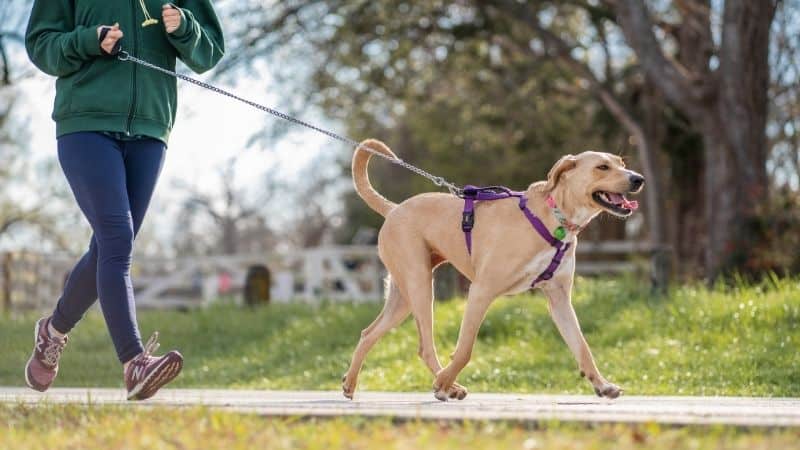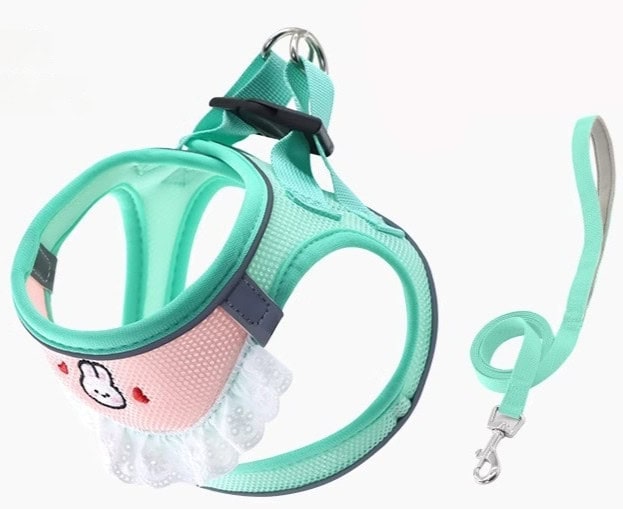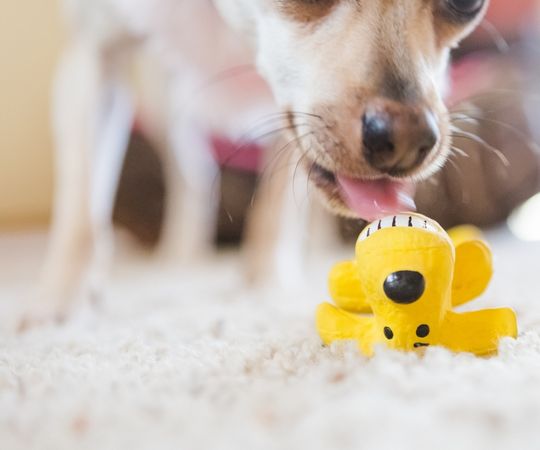
Every dog owner wants what’s best for their furry friend—but when it comes to dog harnesses, is all-day wear actually safe? While harnesses offer better control and reduce neck strain compared to collars, leaving one on constantly could lead to hidden problems. From skin irritation to restricted movement, the answer isn’t as simple as “yes” or “no.” In this guide, we’ll break down the benefits, risks, and smart alternatives so you can make the best choice for your pup’s comfort and safety. Whether your dog is an energetic puller or a laid-back companion, understanding harness use could make all the difference!
Can Dogs Wear Harnesses All the Time?
While dogs can wear harnesses for limited periods, they shouldn’t keep them on all day. A well-fitted harness won’t irritate the skin during short-term use (a few hours), but even the best designs can cause discomfort, skin issues, or restricted movement if worn 24/7.
Only use a harness when necessary—like during walks for better control or safety. Dogs need regular “gear-free” time to stay comfortable and healthy. If your dog is resting or in a crate, it’s best to remove the harness. Prolonged wear may also cause anxiety or limit natural movement.
Benefits of Wearing a Dog Harness
Dog harnesses provide several important advantages for both pets and owners. Here are the key benefits:
Control Pulling
Using a harness gives you better control over your pup, especially if your dog tends to pull on the leash. Because the harness wraps around the chest and shoulders, you can steer your dog more effectively. This helps reduce strain on both you and your dog during walks.
You can find harnesses designed specifically to discourage pulling by redirecting your dog’s movement. This gives you a safer way to manage your dog’s behavior outdoors.
Prevent Escapes
Some breeds and clever escape artists can easily slip out of collars, but harnesses with multiple buckles and secure straps, or that wrap fully around the dog’s body can significantly reduce this risk. This keeps your dog secure during walks or car rides, preventing dangerous dashes into traffic or getting lost.
This feature is especially crucial if your dog tends to get overly excited or anxious in crowded or stimulating environments. The added security of a harness gives owners peace of mind while protecting their adventurous pups.
Protect the Neck
Unlike collars, harnesses do not put pressure on your dog’s neck. When you pull on a collar, weight and force are focused on the throat area. This can cause damage or pain over time. However, a harness spreads the force evenly across your dog’s chest and shoulders. This is important for small breeds and those prone to tracheal collapse or other neck injuries.
Using a harness also helps reduce the risk of choking and injury, making it safer for daily use with dogs of all sizes and health conditions.
Boost Comfort
Comfort depends on a proper fit and the right type of harness for your dog. A soft, padded harness prevents chafing and skin irritation. A harness that fits snugly but not too tightly avoids restricting your dog’s movement or breathing. Look for lightweight, breathable materials to keep your dog cool.
Support Training
A harness is a practical tool for training dogs to walk properly on a leash. It allows you to gently guide your dog without causing pain or harsh corrections. You can use a harness to train your dog to follow or stop pulling by applying slight pressure to specific areas, which encourages positive behavior.
Since harnesses reduce the risk of choking or discomfort, dogs can focus better on learning during training. Harnesses work best when combined with rewards and commands.
Risks of Leaving a Harness on Too Long
Leaving a harness on your pup for extended periods can cause several problems. While harnesses offer benefits, dog owners should also be aware of their potential risks.
Skin Irritation
If your dog wears a harness too long, the material rubbing against their skin can cause irritation. This is especially true if the harness fits too tightly or is made from rough fabric. You might notice red marks, chafing, or even sores on areas like behind the front legs or under the chest.
Dogs with short coats are more prone to raw spots because there’s less hair to protect the skin. Moisture buildup from sweat or dirt trapped under the harness can make irritation worse. Regularly checking and removing the harness to let your dog’s skin breathe helps prevent these problems.
Matted Fur
Wearing the harness for too long can lead to matted fur. The constant pressure and friction in one spot cause hair to tangle and form mats, which can be uncomfortable and painful for your dog.
Moreover, matted fur is harder to clean and can trap dirt, moisture, and bacteria. This increases the chance of skin infections under the mats. You should groom your dog regularly and remove the harness when not needed to avoid these issues.
Discomfort
While harnesses can promote comfort, this is only true when the right harness is chosen. If the harness is too tight, your dog may experience pain; if it’s too loose, it may cause chafing or shift out of place, creating uncomfortable pressure points.
More importantly, never leave it on all day. Prolonged wear can cause discomfort that may alter your dog’s behavior, making them restless or lethargic. Worse still, if a dog consistently feels uncomfortable in their harness, they may develop negative associations with wearing it.
When Should My Dog Wear a Harness?
Here’s a quick guide to when your dog should wear a harness:
| Situation | Harness Recommended? | Reason |
|---|---|---|
| Walking outside | Yes | Control and safety |
| Training sessions | Yes | Guidance and behavior shaping |
| Car rides | Yes | Safety |
| Indoor lounging | No | Risk of irritation or discomfort |
| All-day use | No | Can cause skin and fur problems |
Harness or Collar?
There is no one-size-fits-all answer—it depends on your dog’s individual needs. Collars work well for calm, trained dogs and are great for ID tags, but can harm pullers or small breeds. Harnesses are safer for strong pullers, small dogs, or short-nosed breeds, distributing pressure evenly.
Choosing the Right Fit and Type of Harness
Picking the right harness starts with measuring your dog properly. Measure around their ribcage, just behind the front legs. This helps ensure you buy a harness that fits well and is secure.
Pay attention to the harness fit – neither too tight nor too loose is good. As a rule, you should be able to slide two fingers comfortably between the harness and your dog’s body.
There are different types of dog harnesses to consider:
- Standard harness: Fits around the chest and shoulders.
- No-pull harness: Designed to reduce pulling by attaching the leash in front.
- Step-in harness: Your dog steps into this one, which you secure on top.
Look for adjustable straps. These allow you to change the fit as your dog grows or changes weight. Durable materials matter, too. Pick fabric that can handle regular use and washing.
The right harness not only improves control but also supports your dog’s comfort.
Breathable and Adjustable Chest Harness and Leash Set for Small Pets

Upgrade your furry friend’s walks with our Small Pet Harness! Designed for comfort and safety, this adorable adjustable harness features a 3D embroidered bunny design that adds a playful touch to your pet’s outfit. Perfect for small dogs and cats, it ensures secure adventures while keeping them stylish!
Key Benefits:
- Cute & Functional – The attached bunny bib instantly boosts your pet’s charm, making them the star of every stroll.
- 3M Reflective Strips – Enhanced visibility for nighttime safety, so you and your pet stay safe during evening walks.
- Double Security – Dual buckle design prevents escaping, giving you peace of mind while traveling or exploring.
- Breathable Mesh Fabric – Lightweight and airy for all-day comfort, with adjustable straps for a customized fit.
- Versatile Use – Ideal for walks, travel, or outdoor play—perfect for small breeds!
Frequently Asked Questions
What are the potential risks of leaving a harness on a dog for an extended period?
Wearing a harness too long can cause sores, skin irritation, and hair loss. It may also trap moisture and dirt, leading to infections.
Your dog might experience discomfort or pain if the harness rubs constantly.
What is the recommended duration for a dog to wear a harness?
Generally, your dog can wear a harness for several hours during walks or outdoor activities. Avoid leaving it on all day or overnight.
Take the harness off when your dog is resting, crated, or left alone.
How does continuous harness wear affect a dog’s skin and fur?
Continuous wear can cause chafing where the harness rubs against the skin. Over time, this can lead to hair loss and sores.
Skin may also become irritated, especially if the harness is too tight or dirty.
Are there any harnesses designed to be worn safely for long durations?
Some harnesses are made with soft, breathable materials and adjustable fittings to reduce irritation. These can be more comfortable for longer wear.
Even with these harnesses, you should still give your dog breaks to check their skin and comfort.



